warning TOYOTA RAV4 PHEV 2021 Owners Manual
[x] Cancel search | Manufacturer: TOYOTA, Model Year: 2021, Model line: RAV4 PHEV, Model: TOYOTA RAV4 PHEV 2021Pages: 666, PDF Size: 161.28 MB
Page 429 of 666

427
5
5-5. Using the driving support systems
Driving
trol is operating
• The Parking Support Brake deter - mines that an imm ediate brake opera-
tion is necessary t o avoid a collision.
■The Parking Support Brake func-
tion (static objects) will stop oper - ating when
The function will stop operating if any of
the following conditions are met:
●Hybrid system output restriction con -
trol • The Parking Support Brake is dis -
abled.
• The system determine s that the colli- sion has become avoidable with nor-
mal brake operation.
• The static object is no longer approxi - mately 2 to 4 m (6 to 13 ft.) away from
the vehicle or in the traveling direction
of the vehicle.
●Brake control
• The Parking Support Brake is dis - abled.
• Approximately 2 seconds have
elapsed since the vehicle was stopped by brake control.
• The brake pedal is depressed after
the vehicle is stopped by brake con - trol.
• The static object is no longer approxi -
mately 2 to 4 m (6 to 13 ft.) away from the vehicle or in the traveling direction
of the vehicle.
■Detection range of the Parking Sup -
port Brake function (static objects)
The detection range of the Parking Sup -
port Brake function ( static objects) dif-
fers from the detection range of the Toyota parking assist-sensor. ( →P.418)
Therefore, even if the Toyota parking
assist-sensor detect s an object and pro-
vides a warning, the Parking Support Brake function (static objects) may not
start operating.
■Objects that the Parking Support
Brake function (static objects) may not detect
The sensors may not be able to detect
certain objects, such as the following:
●Pedestrian
●Cotton, snow, and other materials that
are poor reflectors of sonic waves
●Objects which are not perpendicular
to the ground, are not perpendicular to
the traveling direction of the vehicle, are uneven or are waving
●Low objects
●Thin objects such as wires, fences,
ropes and signposts
●Objects that are e xtremely close to
the bumper
●Sharply-angled objects
●Tall objects with upper sections pro-
jecting outwards in the direction of
your vehicle
■Situations in which the Parking Support Brake function (static
objects) may not operate
When the shift lever is in N
■Toyota parking assist-sensor buzzer
Regardless of whether the Toyota park -
ing assist-sensor function is enabled or not ( →P.415), if the Parking Support
Brake function (static objects) is enabled
( →P.421), the front or rear sensors detect an object and brake control and
hybrid system output r estriction control
are performed, the Toyota parking assist-sensor buzzer will sound to notify
the driver of the approximate distance to
the object.
■Situations in which the Parking Support Brake function (static
objects) may operate even if there
is no possibility of a collision
In some situations, s uch as the follow-
ing, the Parking Support Brake function
(static objects) may operate even
though there is no possibility of a colli - sion.
●Vehicle surroundings• When driving on a narrow road
Page 432 of 666

4305-5. Using the driving support systems
*: If equipped
This function will operate in situa-
tions such as the following if a vehi -
cle is detected in the traveling
direction of the vehicle.
■When reversing, a vehicle is
approaching and the brake
pedal is not depressed, or is
depressed late
→ P.408
■The Parking Support Brake func-
tion (rear-crossing vehicles) will operate when
The function will operate when the
PKSB OFF indicator is not illuminated ( →P.170, 171) and all of the following
conditions are met:
●Hybrid system outpu t restriction con-
trol
• The Parking Support Brake is enabled.
• The vehicle speed is approximately 15
km/h (9 mph) or less.
Parking Support Brake
function (rear-crossing
vehicles)*
If a rear radar sensor detects a
vehicle approaching from the
right or left at the rear of the
vehicle and the system deter -
mines that the possibility of a
collision is high, this function
will perform brake control to
reduce the likelihood of an
impact with the approaching
vehicle.
Examples of function opera -
tion
Types of sensors
WARNING
■To ensure the Parking Support
Brake (rear-crossing vehicles)
can operate properly
Observe the following precautions
regarding the rear radar sensors
( →P.408). Failure to do so may cause
a sensor to not ope rate properly, and may cause an accident.
●Do not modify, disassemble or paint the sensors.
●Do not replace a rear radar sensor with a part other than a genuine
part.
●Do not damage the rear radar sen -
sors, and always keep the radar
sensors and their surrounding area on the bumper clean.
●If the area around a rear radar sen - sor is subjected to an impact, the
system may not operate properly
due to a sensor malfunction. Have the vehicle inspected by any autho -
rized Toyota retailer or Toyota
authorized repairer, or any reliable repairer.
●Observe the rear radar sensor han - dling precautions. ( →P.408)
Page 437 of 666

435
5
5-5. Using the driving support systems
Driving
switch is turned off, normal mode and
Eco drive mode w ill not be automati- cally canceled.)
Press the Trail Mode switch
When the switch is pressed, Trail Mode
turns on and the Trail Mode indicator
illuminates on the multi-information dis -
play.
When the switch is pr essed again, the
Trail Mode indicator turns off.
Trail Mode
Trail Mode is a system that per -
forms integrated control for
the AWD, brake and drive force
control systems to assist the
drive power on bumpy roads,
etc.
WARNING
■Before using Trail Mode
Make sure to observe the following
precautions. Failure to observe these precautions may result in an unex -
pected accident.
●Check that the Tra il Mode indicator is illuminated before driving. Trail
Mode will not operate when the
indicator is off.
●Trail Mode is not intended to
expand the limits of the vehicle. Thoroughly check the road condi -
tions and driv e with caution.
●Thoroughly check the road condi-
tions before driving. As Trail Mode
is suitable for driving on bumpy roads, such as those where the tire
o n o n e s i d e s p i n s , t here is a chance
that Trail Mode may not be the most appropriate for other road
conditions.
Turning Trail Mode on
Page 442 of 666
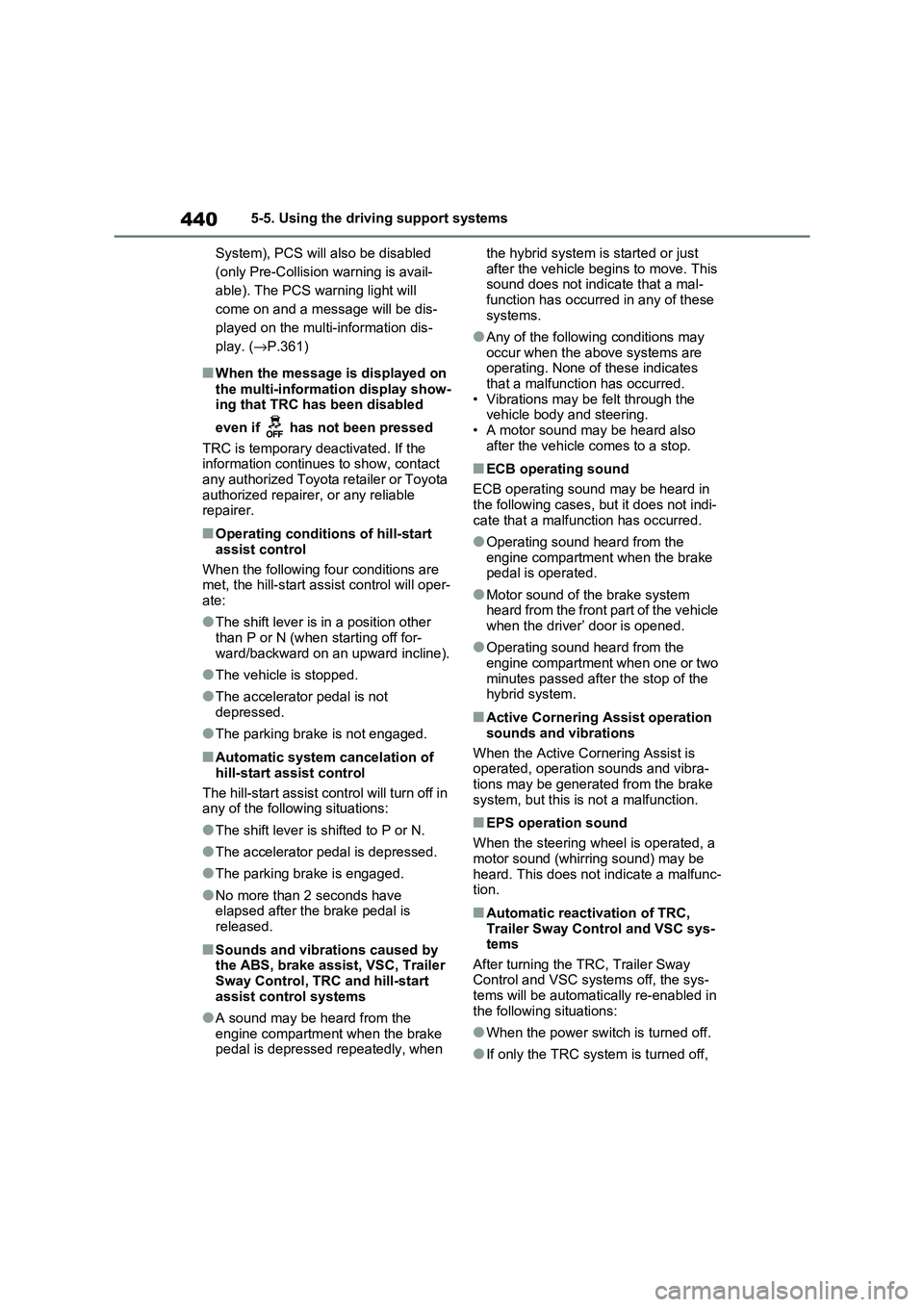
4405-5. Using the driving support systems
System), PCS will also be disabled
(only Pre-Collision warning is avail -
able). The PCS warning light will
come on and a message will be dis -
played on the multi-information dis -
play. ( →P.361)
■When the message is displayed on
the multi-information display show -
ing that TRC has been disabled
even if has not been pressed
TRC is temporary deactivated. If the information continues to show, contact
any authorized Toyota retailer or Toyota
authorized repairer, or any reliable repairer.
■Operating conditions of hill-start
assist control
When the following four conditions are met, the hill-start as sist control will oper-
ate:
●The shift lever is in a position other
than P or N (when starting off for-
ward/backward on an upward incline).
●The vehicle is stopped.
●The accelerator pedal is not
depressed.
●The parking brake is not engaged.
■Automatic system cancelation of
hill-start assist control
The hill-start assist control will turn off in any of the following situations:
●The shift lever is shifted to P or N.
●The accelerator pedal is depressed.
●The parking brak e is engaged.
●No more than 2 seconds have elapsed after the brake pedal is
released.
■Sounds and vibrations caused by
the ABS, brake assist, VSC, Trailer Sway Control, TRC and hill-start
assist control systems
●A sound may be heard from the
engine compartment when the brake
pedal is depressed repeatedly, when
the hybrid system i s started or just
after the vehicle beg ins to move. This sound does not indicate that a mal -
function has occurred in any of these
systems.
●Any of the followin g conditions may
occur when the a bove systems are operating. None of these indicates
that a malfunction has occurred.
• Vibrations may be felt through the vehicle body and steering.
• A motor sound may be heard also
after the vehicle comes to a stop.
■ECB operating sound
ECB operating sound may be heard in
the following cases, but it does not indi-
cate that a malfun ction has occurred.
●Operating sound heard from the
engine compartment when the brake pedal is operated.
●Motor sound of the brake system heard from the front part of the vehicle
when the driver’ door is opened.
●Operating sound heard from the
engine compartment when one or two
minutes passed after the stop of the hybrid system.
■Active Cornering Assist operation
sounds and vibrations
When the Active Cornering Assist is operated, operation sounds and vibra -
tions may be generat ed from the brake
system, but thi s is not a malfunction.
■EPS operation sound
When the steering wheel is operated, a
motor sound (whirring sound) may be
heard. This does not indicate a malfunc - tion.
■Automatic reacti vation of TRC,
Trailer Sway Control and VSC sys -
tems
After turning the TRC, Trailer Sway Control and VSC systems off, the sys -
tems will be automati cally re-enabled in
the following situations:
●When the power switch is turned off.
●If only the TRC syst em is turned off,
Page 444 of 666
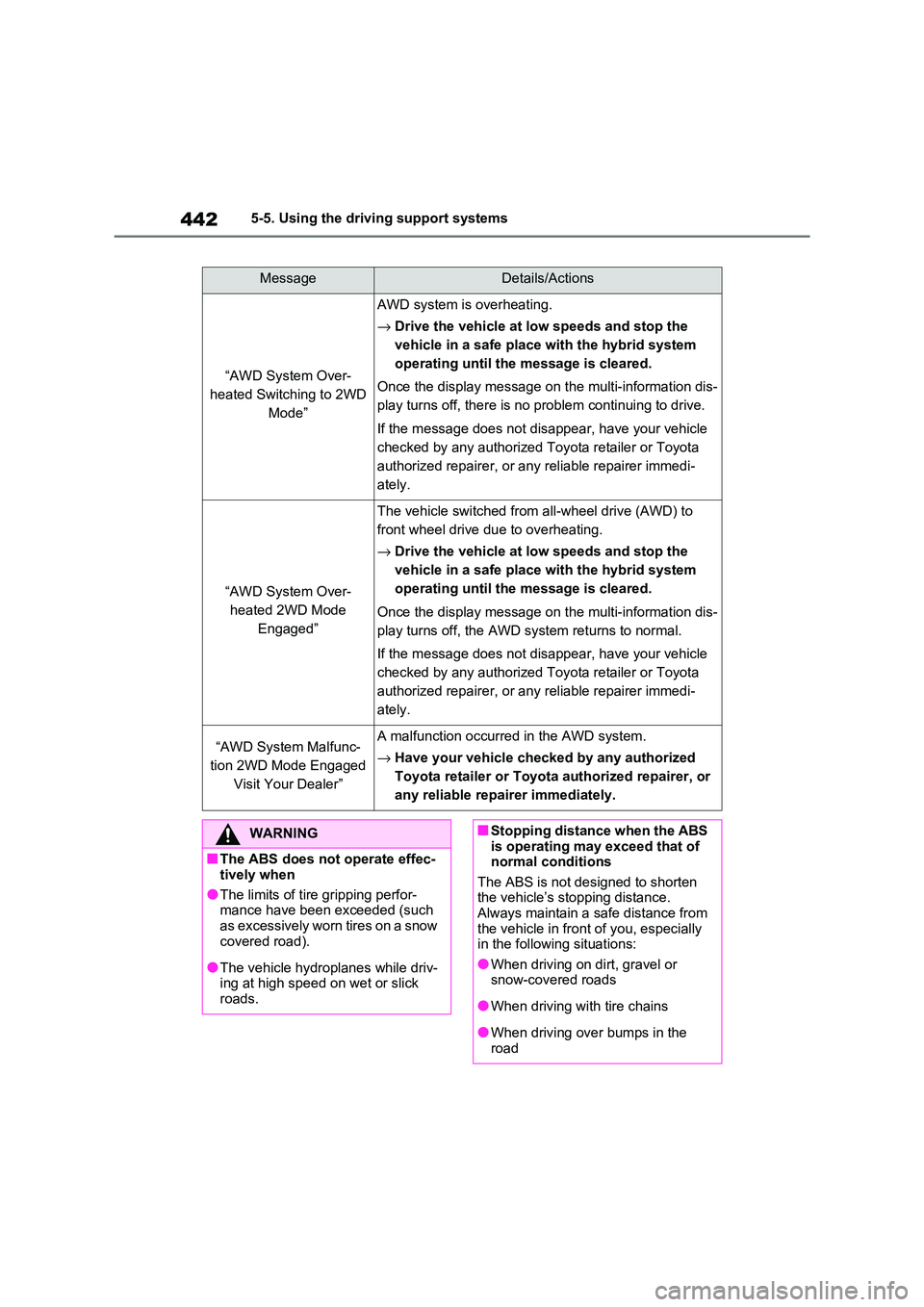
4425-5. Using the driving support systems
MessageDetails/Actions
“AWD System Over-
heated Switching to 2WD
Mode”
AWD system is overheating.
→ Drive the vehicle at low speeds and stop the
vehicle in a safe place with the hybrid system
operating until the message is cleared.
Once the display message on the multi-information dis -
play turns off, there is no p roblem continuing to drive.
If the message does not dis appear, have your vehicle
checked by any authorized Toyota retailer or Toyota
authorized repairer, or any reliable repairer immedi-
ately.
“AWD System Over -
heated 2WD Mode
Engaged”
The vehicle switch ed from all-wheel drive (AWD) to
front wheel drive du e to overheating.
→ Drive the vehicle at low speeds and stop the
vehicle in a safe place with the hybrid system
operating until the message is cleared.
Once the display message on the multi-information dis -
play turns off, the AWD s ystem returns to normal.
If the message does not dis appear, have your vehicle
checked by any authorized Toyota retailer or Toyota
authorized repairer, or any reliable repairer immedi-
ately.
“AWD System Malfunc -
tion 2WD Mode Engaged
Visit Your Dealer”
A malfunction occurr ed in the AWD system.
→ Have your vehicle checked by any authorized
Toyota retailer or Toyota authorized repairer, or
any reliable repairer immediately.
WARNING
■The ABS does not operate effec -
tively when
●The limits of tire gripping perfor -
mance have been exceeded (such
as excessively worn tires on a snow covered road).
●The vehicle hydroplanes while driv - ing at high speed on wet or slick
roads.
■Stopping distance when the ABS
is operating may exceed that of normal conditions
The ABS is not desi gned to shorten
the vehicle’s stopping distance. Always maintain a safe distance from
the vehicle in fron t of you, especially
in the following situations:
●When driving on dirt, gravel or snow-covered roads
●When driving wit h tire chains
●When driving over bumps in the
road
Page 445 of 666
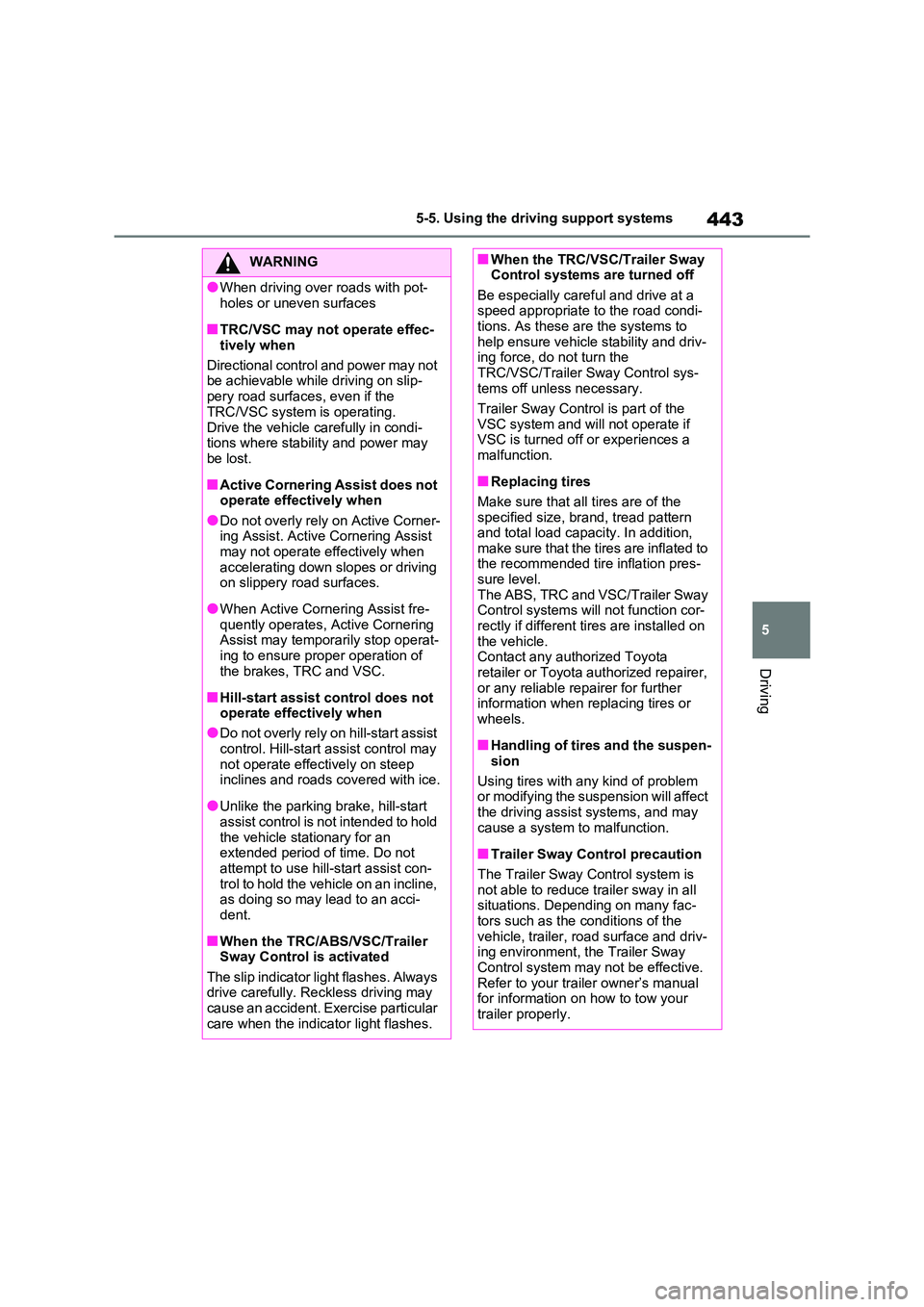
443
5
5-5. Using the driving support systems
Driving
WARNING
●When driving over roads with pot -
holes or uneven surfaces
■TRC/VSC may not operate effec -
tively when
Directional control and power may not be achievable while driving on slip -
pery road surfaces , even if the
TRC/VSC system is operating.
Drive the vehicle carefully in condi - tions where stabilit y and power may
be lost.
■Active Cornering Assist does not
operate effectively when
●Do not overly rely on Active Corner - ing Assist. Active Cornering Assist
may not operate effectively when
accelerating down slopes or driving on slippery road surfaces.
●When Active Cornering Assist fre - quently operates, Active Cornering
Assist may temporarily stop operat -
ing to ensure prop er operation of the brakes, TRC and VSC.
■Hill-start assist control does not operate effectively when
●Do not overly rely on hill-start assist
control. Hill-start assist control may not operate effectively on steep
inclines and roads covered with ice.
●Unlike the parking brake, hill-start
assist control is not intended to hold
the vehicle stationary for an extended period of time. Do not
attempt to use hill-start assist con -
trol to hold the vehicle on an incline, as doing so may lead to an acci-
dent.
■When the TRC/ABS/VSC/Trailer
Sway Control is activated
The slip indicator light flashes. Always drive carefully. Reckless driving may
cause an accident. Exercise particular
care when the indicat or light flashes.
■When the TRC/VSC/Trailer Sway Control systems are turned off
Be especially careful and drive at a
speed appropriate t o the road condi- tions. As these ar e the systems to
help ensure vehicl e stability and driv-
ing force, do not turn the TRC/VSC/Trailer Sway Control sys -
tems off unle ss necessary.
Trailer Sway Control is part of the VSC system and will not operate if
VSC is turned off or experiences a
malfunction.
■Replacing tires
Make sure that all tires are of the specified size, brand, tread pattern
and total load capac ity. In addition,
make sure that the tires are inflated to the recommended tire inflation pres -
sure level.
The ABS, TRC and VSC/Trailer Sway Control systems will not function cor -
rectly if different ti res are installed on
the vehicle. Contact any authorized Toyota
retailer or Toyota a uthorized repairer,
or any reliable repairer for further information when replacing tires or
wheels.
■Handling of tires and the suspen -
sion
Using tires with any kind of problem or modifying the suspension will affect
the driving assist systems, and may
cause a system to malfunction.
■Trailer Sway Control precaution
The Trailer Sway C ontrol system is not able to reduce tr ailer sway in all
situations. Depending on many fac -
tors such as the conditions of the
vehicle, trailer, road surface and driv - ing environment, the Trailer Sway
Control system may not be effective.
Refer to your traile r owner’s manual for information on how to tow your
trailer properly.
Page 446 of 666

4445-5. Using the driving support systems
WARNING
■If trailer sway occurs
Observe the following precautions.
Failing to do so may cause death or serious injury.
●Firmly grip the steering wheel.
Steer straight ahead. Do not try to control trailer sw aying by turning
the steering wheel.
●Begin releasing the accelerator pedal immediately but very gradu -
ally to reduce speed.
Do not increase speed. Do not apply vehicle brakes.
If you make no extreme correction
with the steering or brakes, your vehi-
cle and trailer should stabilize.
( →P.308)
■Secondary Collision Brake (if
equipped)
Do not rely solely upon the Secondary Collision Brake. This system is
designed to help re duce the possibil-
ity of further damage due to a second - ary collision, however, that effect
changes according to various condi -
tions. Overly relyi ng on the system may result in death or serious injury.
Page 447 of 666
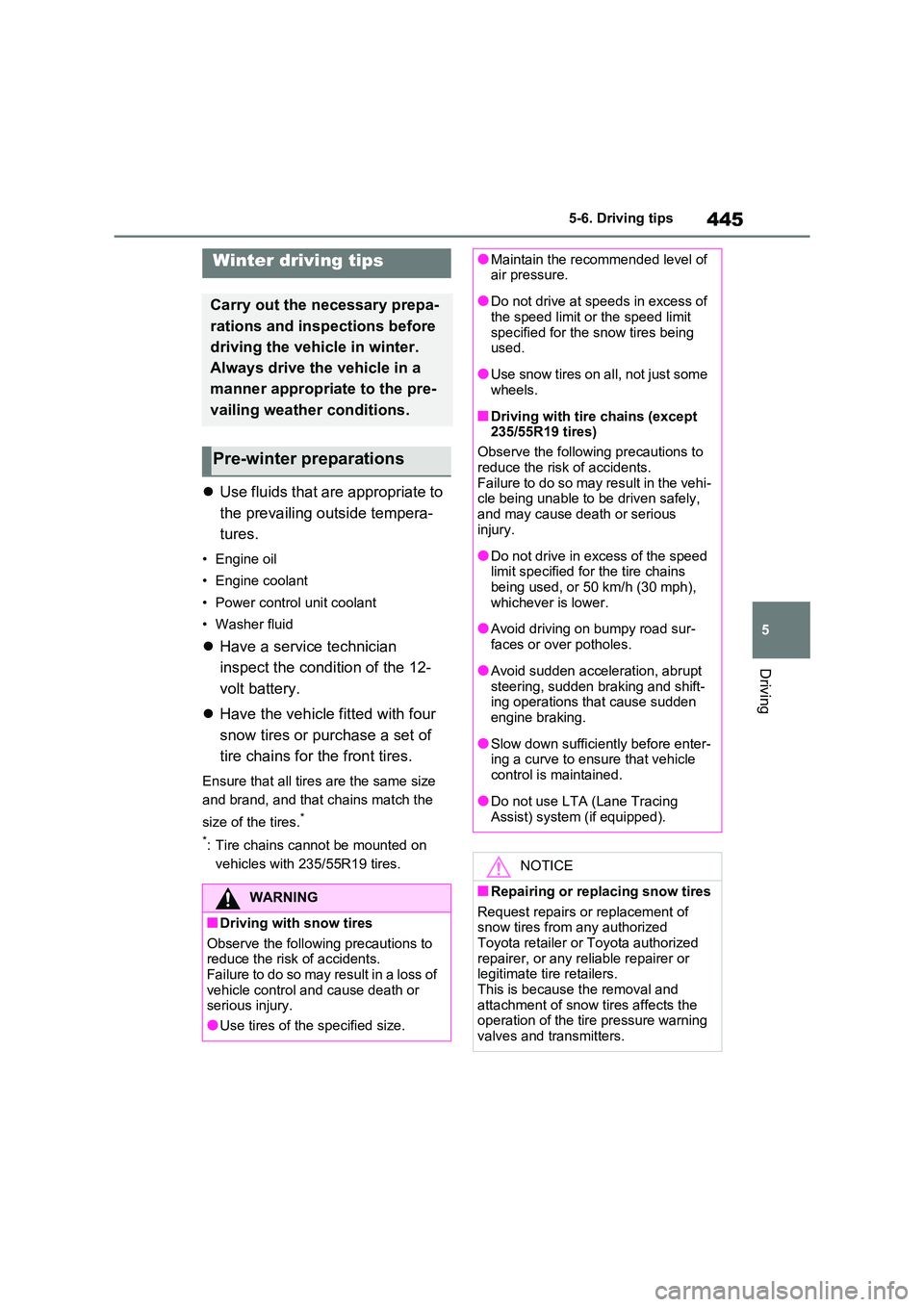
445
5
5-6. Driving tips
Driving
5-6.Driving tips
Use fluids that are appropriate to
the prevailing outside tempera-
tures.
• Engine oil
• Engine coolant
• Power control unit coolant
• Washer fluid
Have a service technician
inspect the condition of the 12-
volt battery.
Have the vehicle fitted with four
snow tires or purchase a set of
tire chains for the front tires.
Ensure that all tires are the same size
and brand, and that chains match the
size of the tires.*
*: Tire chains cannot be mounted on
vehicles with 235/55R19 tires.
Winter driving tips
Carry out the necessary prepa -
rations and inspections before
driving the vehicle in winter.
Always drive the vehicle in a
manner appropriate to the pre -
vailing weather conditions.
Pre-winter preparations
WARNING
■Driving with snow tires
Observe the following precautions to reduce the risk of accidents.
Failure to do so may result in a loss of
vehicle control and cause death or serious injury.
●Use tires of the specified size.
●Maintain the recommended level of air pressure.
●Do not drive at speeds in excess of the speed limit or the speed limit
specified for the snow tires being
used.
●Use snow tires on all, not just some
wheels.
■Driving with tire chains (except
235/55R19 tires)
Observe the following precautions to
reduce the risk of accidents.
Failure to do so may result in the vehi - cle being unable to be driven safely,
and may cause death or serious
injury.
●Do not drive in excess of the speed
limit specified for the tire chains being used, or 50 km/h (30 mph),
whichever is lower.
●Avoid driving on bumpy road sur -
faces or over potholes.
●Avoid sudden acceleration, abrupt
steering, sudden br aking and shift-
ing operations that cause sudden engine braking.
●Slow down sufficiently before enter - ing a curve to ensure that vehicle
control is maintained.
●Do not use LTA (Lane Tracing
Assist) system (if equipped).
NOTICE
■Repairing or replacing snow tires
Request repairs or replacement of snow tires from any authorized
Toyota retailer or Toyota authorized
repairer, or any reliable repairer or legitimate tire retailers.
This is because the removal and
attachment of snow tires affects the operation of the tire pressure warning
valves and transmitters.
Page 448 of 666
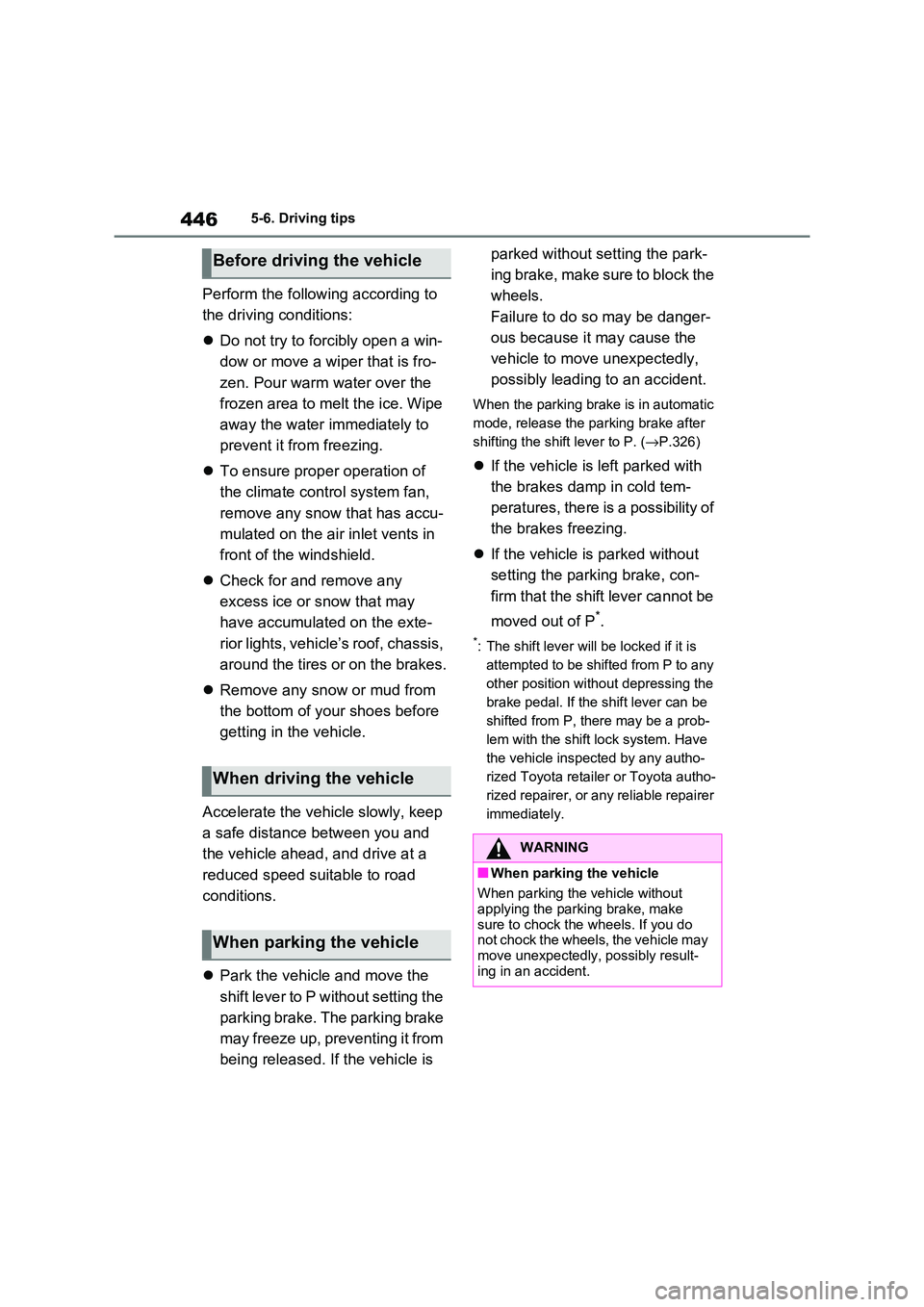
4465-6. Driving tips
Perform the following according to
the driving conditions:
Do not try to forcibly open a win-
dow or move a wiper that is fro -
zen. Pour warm water over the
frozen area to melt the ice. Wipe
away the water immediately to
prevent it from freezing.
To ensure proper operation of
the climate control system fan,
remove any sno w that has accu-
mulated on the air inlet vents in
front of the windshield.
Check for and remove any
excess ice or snow that may
have accumulated on the exte -
rior lights, vehicle’s roof, chassis,
around the tires or on the brakes.
Remove any snow or mud from
the bottom of your shoes before
getting in the vehicle.
Accelerate the veh icle slowly, keep
a safe distance between you and
the vehicle ahead, and drive at a
reduced speed suitable to road
conditions.
Park the vehicle and move the
s hif t le ve r to P w itho u t se tt ing th e
parking brake. The parking brake
may freeze up, preventing it from
being released. If the vehicle is
parked without setting the park -
ing brake, make sure to block the
wheels.
Failure to do so may be danger -
ous because it may cause the
vehicle to move unexpectedly,
possibly leading to an accident.
When the parking brake is in automatic
mode, release the parking brake after
shifting the shift lever to P. ( →P.326)
If the vehicle is left parked with
the brakes damp in cold tem -
peratures, there is a possibility of
the brakes freezing.
If the vehicle is parked without
setting the parking brake, con -
firm that the shift lever cannot be
moved out of P*.
*: The shift lever will be locked if it is
attempted to be shifted from P to any
other position with out depressing the
brake pedal. If the shift lever can be
shifted from P, t here may be a prob-
lem with the shift lock system. Have
the vehicle inspected by any autho -
rized Toyota retailer or Toyota autho -
rized repairer, or any reliable repairer
immediately.
Before driving the vehicle
When driving the vehicle
When parking the vehicle
WARNING
■When parking the vehicle
When parking the vehicle without
applying the parki ng brake, make
sure to chock the wheels. If you do
not chock the wheels, the vehicle may move unexpectedly, possibly result-
ing in an accident.
Page 450 of 666

4485-6. Driving tips
Specific design characteristics
give it a higher center of gravity
than ordinary passenger cars.
This vehicle design feature
causes this type of vehicle to be
more likely to rollover. And, utility
vehicles have a significantly
higher rollover rate than other
types of vehicles.
An advantage of the higher
ground clearance is a better view
of the road allowing you to antici -
pate problems.
It is not designed for cornering at
the same speeds as ordinary
passenger cars any more than
low-slung sports cars are
designed to perform satisfactorily
under off-road conditions. There -
fore, sharp turns at excessive
speeds may cause the vehicle to
rollover.
When driving your vehicle off-road,
please observe the following pre -
Utility vehicle precau-
tions
This vehicle belongs to the
utility vehicle class, which has
higher ground clearance and
narrower tread i n relation to
the height of its center of grav -
ity to make it capable of per -
forming in a wide variety of off-
road applications.
Utility vehicle feature
WARNING
■Utility vehicle precautions
Always observe the following precau -
tions to minimize the risk of death, serious injury or damage to your vehi-
cle:
●In a rollover crash, an unbelted per - son is significantly more likely to die
than a person wearing a seat belt.
Therefore, the driver and all pas -
sengers should alwa ys fasten their seat belts.
●Avoid sharp turns or abrupt maneu - vers, if at all possible.
Failure to operate this vehicle cor-
rectly may result in loss of control or vehicle rollover causing death or
serious injury.
●Loading cargo on the roof luggage
carrier (if equipped) will make the
center of the vehicle gravity higher. Avoid high speeds, sudden starts,
sharp turns, sudden braking or
abrupt maneuvers, otherwise it may result in loss of control or vehicle
rollover due to failure to operate this
vehicle correctly.
●Always slow down in gusty cross -
winds. Because of its profile and higher center of gravity, your vehi -
cle is more sensitive to side winds
than an ordinary passenger car. Slowing down will allow you to have
better control.
●Do not drive horizontally across
steep slopes. Driving straight up or
straight down is preferred. Your vehicle (or any sim ilar off-road vehi-
cle) can tip over sideways much
more easily than forward or back- ward.
Off-road driving